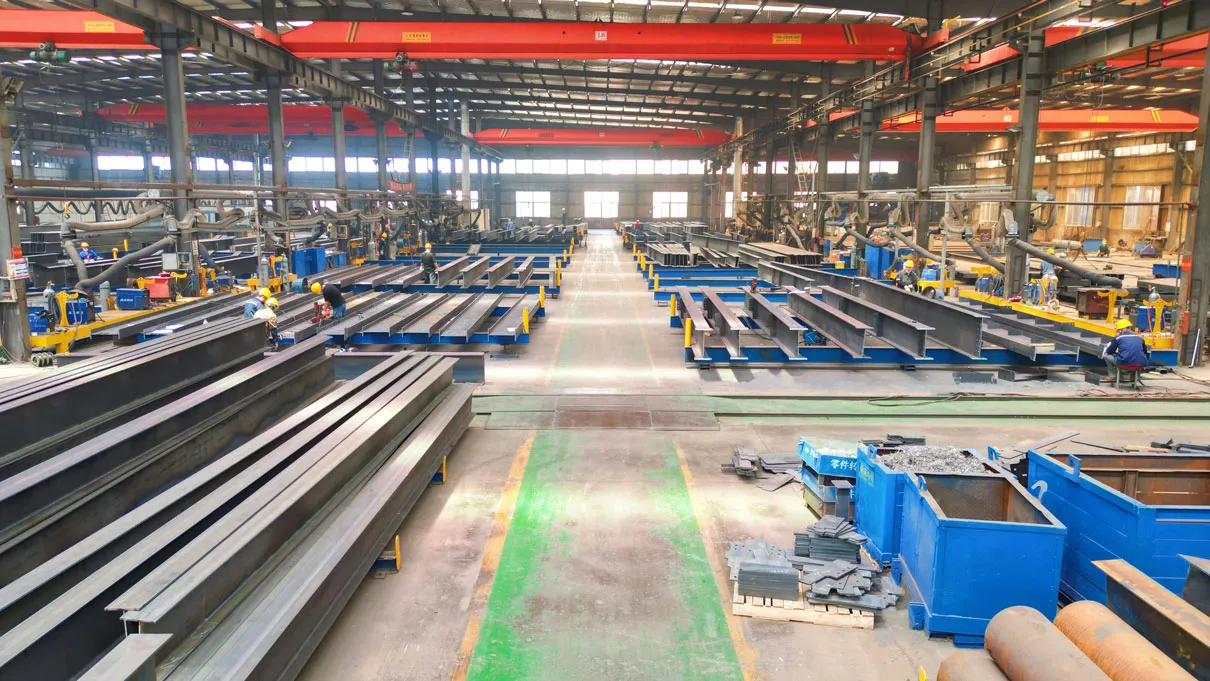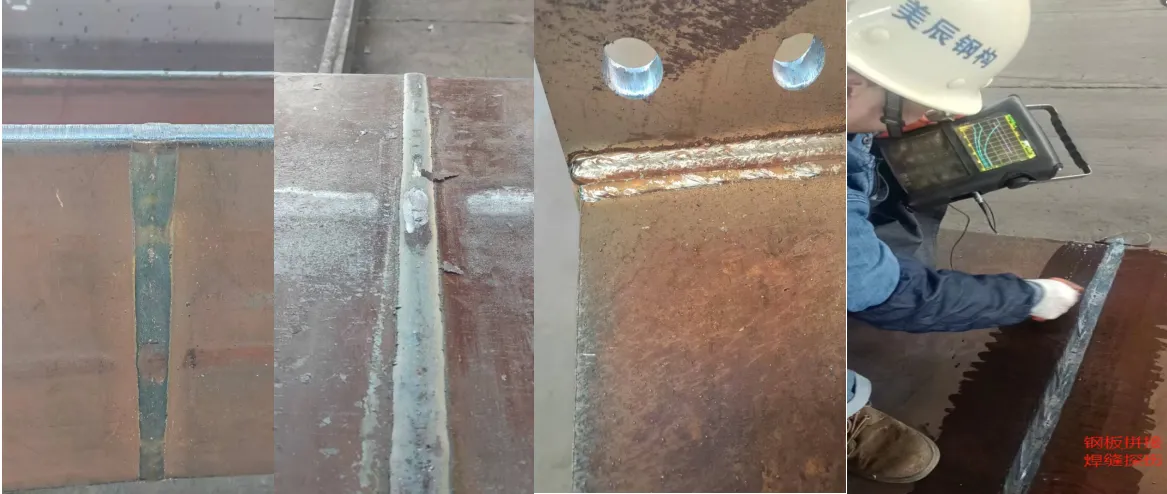Time:2025-10-14 03:03:15 Source:Sanjian Meichen Steel Structure
In the field of industrial and commercial construction, precision in steel structure fabrication directly determines the safety, durability, and performance of the entire project.
For EPC contractors and engineering firms, choosing a reliable steel structure manufacturer means partnering with a supplier capable of delivering not just steel components—but structural integrity and long-term performance.

At Meichen Steel Structure, every beam, column, and frame is produced under strict compliance with national and international standards, including GB50205-2020 (Code for Acceptance of Construction Quality of Steel Structures) and GB50661-2011 (Code for Welding of Steel Structures).
We follow a systematic process covering material inspection, fabrication, welding, and quality testing to ensure every structural component meets the highest industry standards.
Before fabrication begins, all raw materials undergo a comprehensive inspection process to ensure consistency, mechanical strength, and weldability.

Our process includes:
Verification of quality certificates and test reports for 100% of steel plates, sections, and pipe materials.
Mechanical performance tests, including yield strength, tensile strength, elongation, and thickness tolerance checks.
Witness sampling and re-inspection of steel plates in accordance with Appendix A of GB50205-2020, ensuring conformity with national and design specifications.
Testing of welding materials, such as electrodes and wires, for chemical composition and mechanical performance before approval for use.
Incoming material inspection workflow:
Document & report review → Surface and flatness check → Dimensional inspection → Thickness measurement → Storage approval → Witness sampling → Laboratory re-inspection → Approval for fabrication
Through this multi-stage inspection process, Meichen ensures that every ton of steel entering our plant is fully traceable and verifiable.
All fabrication works at Meichen Steel Structure strictly follow the GB50205-2020 standards and detailed shop drawings validated by our engineering team.
Key fabrication procedures include:
Process Planning:
Each project starts with a fabrication procedure specification based on the design drawings and welding codes.
Material Preparation:
All steel members are straightened before cutting.
Allowances are made for weld shrinkage, cutting, and milling.
Edges requiring machining are trimmed by at least 2mm.
Cutting and Drilling:
High-strength bolt holes are drilled (not punched), with tolerances conforming to GB50205-2020.
Cut surfaces are clean, free from rust and slag, and burrs are removed after cutting.
Surface Treatment:
Friction surfaces for high-strength bolt connections are treated by shot blasting or sandblasting to achieve the specified slip coefficient.
Friction coefficient tests are performed before mass production.
Dimensional Accuracy:
For secondary beams longer than 10 meters, a camber of L/800 is introduced.
H-beam or box beam splice welds are staggered by more than 200mm between flange and web.
Welding is one of the most critical stages in steel structure fabrication.
At Meichen Steel Structure, all welding work is performed in accordance with GB50661-2011 and the GB11345 ultrasonic testing standard.
We use automatic submerged arc welding (SAW) for major joints and ensure double-sided full penetration for critical connections.
Welding procedures and requirements:
Welding Sequence:
Proper sequencing minimizes residual stress and distortion in steel members.
Joint Preparation:
For plates ≥30mm thick, ultrasonic testing (UT) is carried out before welding to prevent lamellar tearing.
Weld Quality Level:
Full penetration groove welds for beam-to-column connections must reach Grade Ⅱ or higher.
100% ultrasonic inspection is required for Level Ⅰ and Ⅱ welds.
Acceptance criteria conform to GB11345, Level Ⅲ and above.
Weld appearance must meet Level Ⅲ visual quality standards.
Low-Temperature Welding:
For ambient temperatures below 0°C, preheating and temperature control procedures are applied to prevent cracking.
Defect Repair:
Welders are not permitted to repair cracks without authorization. A repair plan must be approved and implemented under supervision.

| Component | Location | Weld Type | Quality Requirement |
|---|---|---|---|
| Column Base Plate | Anchor plate interface | Full penetration weld | Grade Ⅰ, 100% UT |
| Column Splice | Vertical seam | Full penetration weld | Grade Ⅰ |
| Beam-Column Joint (within ±600mm zone) | Vertical seam | Full penetration weld | Grade Ⅰ |
| Column-Brace Connection | Vertical seam | Full penetration weld | Grade Ⅱ |
| Base Plate (top 100mm zone) | Vertical seam | Full penetration weld | Grade Ⅱ |
| Column Top Cap | Horizontal seam | Full penetration weld | Grade Ⅱ |
| Embedded Column Base | Connection weld | Full penetration weld | Grade Ⅲ, surface finish per Grade Ⅱ |
| Exposed Column Base | Plate connection | Full penetration weld | Grade Ⅱ |
| Column Corner Joint | Partial penetration weld | Depth ≥½ plate thickness, ≥14mm | |
| Beam Web Splice | Longitudinal seam | Full penetration weld | Grade Ⅱ |
| Beam Flange to Column | Connection weld | Full penetration weld | Grade Ⅱ |
| H-Beam End Plate | Anchor interface | Full penetration weld | Grade Ⅰ, 100% UT |
| Beam-Column Connection | Rigid joint | Full penetration weld | Grade Ⅰ, 50% UT |
| All other connections | As per design | Full penetration weld | Grade Ⅱ, 100% UT |
To guarantee long-term structural performance, Meichen applies strict testing protocols at every stage:
Weld Inspection & Testing:
100% visual inspection for all welds
Ultrasonic testing (UT) for Level Ⅰ and Ⅱ welds
Sample acceptance criteria:
Nonconforming rate <2% → batch accepted
Nonconforming rate 2–5% → double re-inspection
Nonconforming rate >5% → batch rejected
Any cracks → re-inspection of entire batch
All inspection results are documented and traceable, ensuring compliance with both GB and ISO standards.
At Meichen Steel Structure, we believe that true quality comes from control—not inspection alone.
Our plant operates with a fully digitalized workflow—from Tekla 3D modeling to automated welding and non-destructive testing (NDT)—ensuring precision, repeatability, and traceability across every project.
Every column, beam, and connection we deliver represents our commitment to:
Precision manufacturing
Compliance with GB, ISO, ASTM, and EN standards
Full inspection and traceability
Long-term reliability for EPC contractors and end users
In today’s competitive EPC and industrial construction markets, choosing the right steel structure partner means choosing reliability, quality assurance, and project success.
By following GB50205-2020 and GB50661-2011 standards throughout the fabrication and inspection process, Meichen Steel Structure ensures that every component we produce meets the highest expectations for performance and safety.
Meichen Steel Structure — Your trusted partner for precision-engineered, high-performance steel structures.